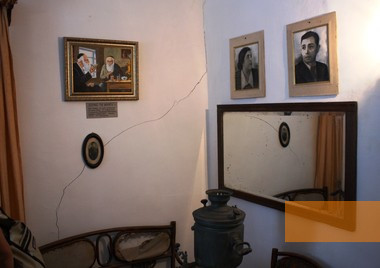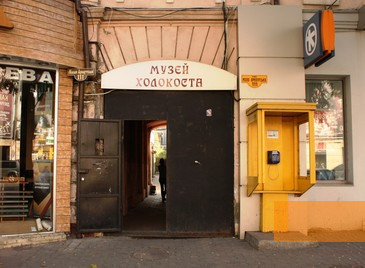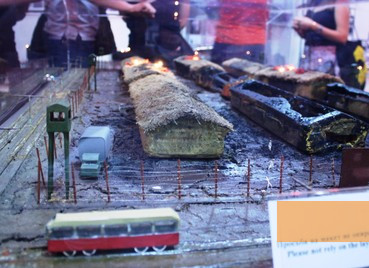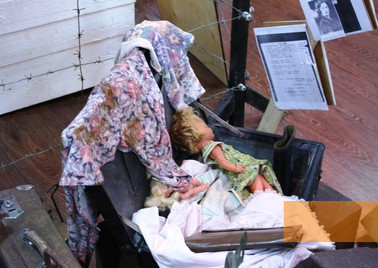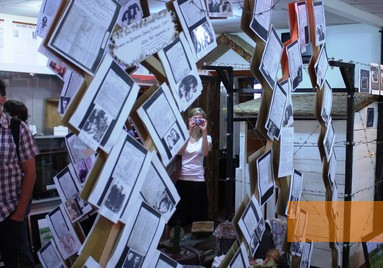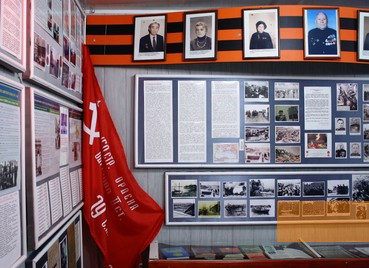The Holocaust Museum in the Ukrainian port city of Odessa displays the fate of the Odessa Jews during World War II. At least half of the 180,000 Odessa Jews perished during the Holocaust.
During the 19th century the port city of Odessa developed into one of the most important centre of Russian Judaism, being the home to many Jewish intellectuals and writers. Prior to the Second World War, about 180,000 Jews lived in Odessa making up around one third of the population. After several weeks of siege, German and their allied Romanian troops took the city on October 16, 1941. From now on Odessa was under Romanian occupation - the city became the capital of the romanian-occupied region called Transnistria. A part of the Jewish population had been able to flee before the arrival of the German and Romanian armies; there were probably between 80,000 and 100,000 Jews in Odessa on the day of its occupation. Together with the Romanian troops, the Sonderkommando 11b (mobile killing unit) marched into Odessa. On the following day, the Romanians ordered the registration of all Jews. Many were arrested, and Jewish intellectuals were immediately executed. On October 22, 1941, a bomb went off in an administration building, killing 67 people, amongst them several Romanian and German officers. The response of the occupying forces was brutal: shortly afterwards, Romanian troops tracked down Jews in the whole city and shot or hanged them. Romanian soldiers shot between 10,000 and 23,000 Jews in a closed off part of the port. The Sonderkommando 11b also took part in the massacre that lasted for days. Romanian constabulary brought about 2,000 arrested Jews to an out of order well shaft. The Sonderkommando shot all the Jews there, the bodies falling into the well shaft. At the end of October 1941, the Romanians continued their murders outside the city: between 16,000 and 20,000 Jews from Odessa were herded into the town of Dalnik and murdered there. At the beginning of November, the remaining 35,000 were forced into two ghettos, where many of them died. At the end of 1941, all of the ghetto residents were deported to Transnistria, the Romanian-controlled part of the Ukraine, and murdered in the Bogdanovka camp.
Romanian soldiers and units of the SS-Einsatzgruppe D (mobile killing squad) murdered at least 70,000 Jews. Around 20,000 Jews were deported from the ghettos of Odessa and perished in Transnistria.
Several memorials in Odessa commemorate the fate of the port city's Jews. The Holocaust Museum was opened on June 22, 2009 and was established at the initiative of various Jewish organisations as well as former prisoners of ghettos and camps.
At first the permanent exhibition provides a general introduction on the Holocaust, then concentrating on the fate of the Jews of Odessa and Transnistria. Further topics of the exhibition include Jewish life before the Holocaust, Jewish soldiers in the Red Army and »Righteous among the Nations«, i.e. gentiles who saved Jews. In addition to the permanent exhibition the Museum offers audio- and video-interviews, a library and a memorial room.
At first the permanent exhibition provides a general introduction on the Holocaust, then concentrating on the fate of the Jews of Odessa and Transnistria. Further topics of the exhibition include Jewish life before the Holocaust, Jewish soldiers in the Red Army and »Righteous among the Nations«, i.e. gentiles who saved Jews. In addition to the permanent exhibition the Museum offers audio- and video-interviews, a library and a memorial room.
- Name
- Oдесский Музей Холокоста
- Address
-
Malaya Arnautskaya ul, 111
65007 Odessa - Phone
- +38(048)722 60 97
- Web
- https://ujew.com.ua/objects/odesskaya-oblast/odessa/muzej-holokosta3
- museum-holocaust@mail.ru
- Open
- Tuesday to Friday 11 a.m. to 6 p.m., Sunday 10 a.m. to 2 p.m., closed on Saturdays and Mondays.
- Possibilities
- Guided tours, educational offers, events, library


